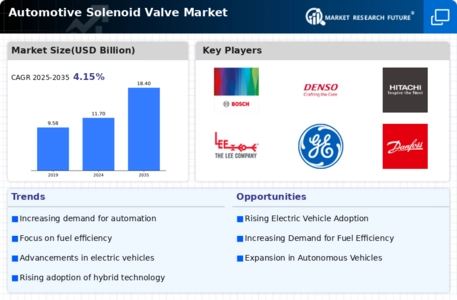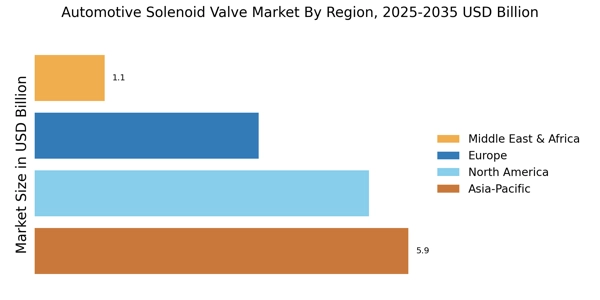Growth in Automotive Production
The resurgence in automotive production is a pivotal driver for the Automotive Solenoid Valve Market. As manufacturers ramp up production to meet consumer demand, the need for solenoid valves in various applications, including fuel injection and transmission systems, is increasing. Recent data indicates that automotive production levels are on an upward trajectory, with several regions reporting significant year-on-year growth. This trend suggests a robust market for solenoid valves, as they play a crucial role in enhancing vehicle performance and efficiency. Consequently, the Automotive Solenoid Valve Market is likely to benefit from this production boom, as more vehicles require advanced solenoid valve technologies.
Increasing Adoption of Hybrid Vehicles
The shift towards hybrid vehicles is influencing the Automotive Solenoid Valve Market. Hybrid vehicles, which combine internal combustion engines with electric propulsion, require sophisticated solenoid valve systems to manage various functions, such as cooling and fuel delivery. As consumers become more environmentally conscious, the demand for hybrid vehicles is expected to rise, thereby increasing the need for solenoid valves. Market analysis suggests that the hybrid vehicle segment is likely to expand, driven by advancements in battery technology and government incentives. This growth presents a significant opportunity for the Automotive Solenoid Valve Market, as manufacturers seek to innovate and provide solutions tailored to hybrid applications.
Technological Innovations in Valve Design
Technological advancements in solenoid valve design are a key driver for the Automotive Solenoid Valve Market. Innovations such as miniaturization, improved materials, and enhanced control mechanisms are enabling the development of more efficient and reliable solenoid valves. These advancements not only improve performance but also reduce manufacturing costs, making solenoid valves more accessible to automotive manufacturers. As the industry continues to evolve, the integration of smart technologies and IoT capabilities into solenoid valves is anticipated to further enhance their functionality. This trend suggests a promising future for the Automotive Solenoid Valve Market, as manufacturers seek to leverage these innovations to meet the demands of modern vehicles.
Regulatory Pressure for Emission Reductions
Regulatory frameworks aimed at reducing vehicle emissions are shaping the Automotive Solenoid Valve Market. Governments worldwide are implementing stringent emission standards, compelling manufacturers to adopt technologies that enhance fuel efficiency and reduce pollutants. Solenoid valves are integral to achieving these objectives, as they optimize engine performance and control emissions. The market is witnessing a shift towards more efficient solenoid valve designs that comply with these regulations. As the automotive industry adapts to these changes, the demand for advanced solenoid valves is likely to increase, positioning the Automotive Solenoid Valve Market for growth in response to regulatory pressures.
Rising Demand for Advanced Driver Assistance Systems
The increasing emphasis on safety and automation in vehicles is driving the Automotive Solenoid Valve Market. Advanced Driver Assistance Systems (ADAS) are becoming standard in modern vehicles, necessitating the integration of solenoid valves for functions such as electronic stability control and automatic braking. This trend is expected to propel the market, as the demand for enhanced safety features continues to rise. According to industry estimates, the ADAS market is projected to grow significantly, which in turn will likely boost the demand for solenoid valves. As manufacturers strive to meet regulatory requirements and consumer expectations, the Automotive Solenoid Valve Market is poised for substantial growth.


















Leave a Comment